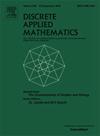Bounds on Graceful k-colorings of graphs
IF 1
3区 数学
Q3 MATHEMATICS, APPLIED
引用次数: 0
Abstract
We investigate the graceful -coloring introduced by Gary Chartrand in 2015. The graceful -coloring of a graph consists of a proper vertex coloring , , that induces a proper edge coloring defined by , where . The smallest positive integer for which a graph has a graceful -coloring is called the graceful chromatic number of and is denoted by . In this paper, we improve a previous upper bound for the graceful chromatic number of an arbitrary graph, showing that , where is the maximum degree of the graph . This also implies an improvement over the first bound given for complete graphs. Moreover, we study this problem within the context of cubic graph classes, determining the exact value of the graceful chromatic number of each member of the infinite families of the Generalized Blanuša and the Loupekine snarks.
图的优美k色的界
我们研究了Gary Chartrand在2015年推出的优雅k色。图G的优美k-染色由一个适当的顶点染色π:V(G)→{1,2,…,k}, k≥1组成,它引出一个适当的边染色π ':E(G)→{1,2,…,k−1}定义为π ' (uv)=|π(u)−π(V)|,其中uv∈E(G)。图G具有优美k着色的最小正整数k称为G的优美色数,用χg(G)表示。本文改进了任意图优美色数的上界,证明了χg(G)≤2Δ2−Δ+1,其中Δ是图G的最大度。这也暗示了对完全图的上界的改进。此外,我们在三次图类的背景下研究了这个问题,确定了广义Blanuša和Loupekine snks无限族中每个成员的优美色数的精确值。
本文章由计算机程序翻译,如有差异,请以英文原文为准。
求助全文
约1分钟内获得全文
求助全文
来源期刊

Discrete Applied Mathematics
数学-应用数学
CiteScore
2.30
自引率
9.10%
发文量
422
审稿时长
4.5 months
期刊介绍:
The aim of Discrete Applied Mathematics is to bring together research papers in different areas of algorithmic and applicable discrete mathematics as well as applications of combinatorial mathematics to informatics and various areas of science and technology. Contributions presented to the journal can be research papers, short notes, surveys, and possibly research problems. The "Communications" section will be devoted to the fastest possible publication of recent research results that are checked and recommended for publication by a member of the Editorial Board. The journal will also publish a limited number of book announcements as well as proceedings of conferences. These proceedings will be fully refereed and adhere to the normal standards of the journal.
Potential authors are advised to view the journal and the open calls-for-papers of special issues before submitting their manuscripts. Only high-quality, original work that is within the scope of the journal or the targeted special issue will be considered.
 求助内容:
求助内容: 应助结果提醒方式:
应助结果提醒方式:


